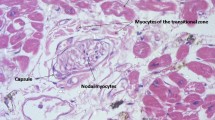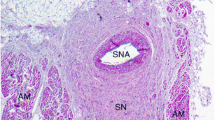Abstract
Histological identification of the human sinoatrial node (SAN) remains a challenge. Conventional identification methods, such as Lev’s method, have certain limitations. The aim of our study was to develop a new histological identification method that could properly identify the sinoatrial node, applicable to the immunohistochemical study of intra-nodal structures. Thirty-nine human autopsied hearts were included in this study. The cases included 23 men and 16 women ranging in age from 20 to 99 years. The sinoatrial area from eight control samples was cut in the vertical section using the conventional Lev’s method. In our new method, called the “En face one-block method,” the sinoatrial node was cut in “En face” at the junction of the right border of the right appendage and superior vena cava, placed in one long cassette, and serially cut using a microtome. Immunostaining was performed using primary antibodies against CD31, podoplanin (D2-40), S-100, and other proteins. The average area of the SAN on the slide glass in our new method was 32.2 mm2, which was significantly larger than that (3.59 mm2) of the control samples by Lev’s method. The SAN area was positively correlated with age (r = 0.357; p = 0.026), especially in women (r = 0.626; p = 0.0095). The SAN group had significantly lower percentage of CD31-positive blood capillaries, higher percentage of podoplanin-positive lymphatic channels, and S-100-positive peripheral nerves. We successfully developed a novel cutting method applicable to immunohistochemical studies, with which we could provide a bird’s-eye view of the sinoatrial nodes.






Similar content being viewed by others
Data availability
The data that support the findings of this study are available from the corresponding author upon reasonable request.
References
Benvenuti LA, Aiello VD, Higuchi Mde L, Palomino SA (1997) Immunohistochemical expression of atrial natriuretic peptide (ANP) in the conducting system and internodal atrial myocardium of human hearts. Acta Histochem 99(2):187–193
Boyett MR, Honjo H, Kodoma I (2000) The sinoatrial node, a heterogeneous pacemaker structure. Cardiovasc Res 47:658–687
Chandler N, Aslanidi O, Buckley D et al (2011) Computer three-dimensional anatomical reconstruction of the human sinus node and a novel paranodal area. Anat Rec (hoboken) 294:970–979
Csepe TA, Zhao J, Hansen BJ et al (2016) Human sinoatrial node structure: 3D microanatomy of sinoatrial conduction pathways. Prog Biophys Mol Biol 120:164–178
Eliska O, Elisková M (1976) Lymph drainage of sinu-atrial node in man and dog. Acta Anat (basel) 96(3):418–428
Eriksson A, Thornell LE (1979) Intermediate (skeletin) filaments in heart Purkinje fibres. A correlative morphological and biochemical identification with evidence of a cytoskeletal function. J Cell Biol 80:231–247
Fedorov VV, Glukhov AV, Chang R et al (2010) Optical mapping of the isolated coronary perfused human sinus node. J Am Coll Cardiol 56:1386–1394
Ferrans VJ, Rodriguez ER (1991) Ultrastructure of the normal heart. In: Silver MD (ed) Cardiovascular pathology, vol 1, 2nd edn. Churchill Livingstone, Edinburgh, pp 43–101
Fregoso SP, Hoover DB (2012) Development of cardiac parasympathetic neurons, glial cells, and regional cholinergic innervation of the mouse heart. Neuroscience 221:28–36
Gonzalez-Martinez T, Perez-Piñera P, Díaz-Esnal B, Vega JA (2003) S-100 proteins in the human peripheral nervous system. Microsc Res Tech 60(6):633–638
Gumina RJ, Kirschbaum NE, Rao PN, vanTuinen P, Newman PJ (1996) The human PECAM1 gene maps to 17q23. Genomics 34:229–232
Inoue S, Shinohara F, Niitani H, Gotoh K (1986) A new method for the histological study of aging changes in the sinoatrial node. Jpn Heart J 27:653–660
James T, Burch GE (1958) The atrial coronary arteries in man. Circulation 17(1):90–98
Kahn H, Bailey D, Marks A (2002) Monoclonal antibody D2–40, a new marker of lymphatic endothelium, reacts with Kaposi’s sarcoma and a subset of angiosarcomas. Mod Pathol 15(4):434–440
Kashou AH, Basit H, Chhabra L (2022) Physiology, sinoatrial node (SA node). Statpearls, Treasure Island (FL) https://www.ncbi.nlm.nih.gov/books/NBK459238/
Keith A, Flack M (1907) The form and nature of the muscular connections between the primary divisions of the vertebrate heart. J Anat Physiol 41:172–189
Kübler W, Schömig A, Senges J (1985) The conduction and cardiac sympathetic systems: metabolic aspects. J Am Coll Cardiol 5(6):157B-161B
Lev M (1954) Aging changes in the human sinoatrial node. J Gerontol 9:1–9
Lev M, Watne AL (1954) Method for routine histopathologic study of human sinoatrial node. AMA Arch Pathol 57:168–177
Marionneau C, Couette B, Liu J et al (2005) Specific pattern of ionic channel gene expression associated with pacemaker activity in the mouse heart. J Physiol 562:223–234
Matsuyama TA, Inoue S, Kobayashi Y et al (2004) Anatomical diversity and age-related histological changes in the human right atrial posterolateral wall. Europace 6(4):307–315
Monfredi O, Dobrzynski H, Mondal T, Boyett MR, Morris GM et al (2010) The anatomy and physiology of the sinoatrial node—a contemporary review. Pacing Clin Electrophysiol 33:1392–1406
Muro S, Tsukada Y, Harada M, Ito M, Akita K (2019) Anatomy of the smooth muscle structure in the female anorectal anterior wall: convergence and anterior extension of the internal anal sphincter and longitudinal muscle. Colorectal Dis 21(4):472–480
Muro S, Kim J, Tsukada S, Akita K (2022) Significance of the broad non-bony attachments of the anterior cruciate ligament on the tibial side. Sci Rep 12:6844
Ogawa Y, Itoh H, Nakagawa O et al (1995) Characterization of the 5′-flanking region and chromosomal assignment of the human brain natriuretic peptide gene. J Mol Med (berl) 73(9):457–463
Ovcina F, Cemerlić D (1997) Clinical importance of intramural blood vessels in the sino-atrial segment of the conducting system of the heart. Surg Radiol Anat 19(6):359–363
Paulin D, Li Z (2004) Desmin: a major intermediate filament protein essential for the structural integrity and function of muscle. Exp Cell Res 301(1):1–7
Sánchez-Quintana D, Cabrera JA, Farré J, Climent V, Anderson RH, Ho SY (2005) Sinus node revisited in the era of electroanatomical mapping and catheter ablation. Heart 91(2):189–194
Sawabe M, Saito M, Naka M et al (2006) Standard organ weights among elderly Japanese who died in hospital, including 50 centenarians. Pathol Int 56(6):315–323
Schindelin J, Arganda-Carreras I, Frise E et al (2012) Fiji: an open-source platform for biological-image analysis. Nat Methods 9:676–682. https://doi.org/10.1038/nmeth.2019
Schneider C, Rasband W, Eliceiri K (2012) NIH Image to ImageJ: 25 years of image analysis. Nat Methods 9(7):671–675. https://doi.org/10.1038/nmeth.2089
Shiraishi I, Takamatsu T, Minamikawa T, Onouchi Z, Fujita S (1992) Quantitative histological analysis of the human sinoatrial node during growth and aging. Circulation 85(6):2176–2184
Skeper JN (1989) An immunocytochemical study of the sinuatrial node and atrioventricular conducting system of the rat for atrial natriuretic peptide distribution. Histochem J 21(2):72–78
Song W, Wang H, Wu Q (2015) Atrial natriuretic peptide in cardiovascular biology and disease (NPPA). Gene 569(1):1–6
Tellez JO, Dobrzynski H, Greener ID (2006) Differential expression of ion channel transcripts in atrial muscle and sinoatrial node in rabbit. Circ Res 99(12):1384–1393
Verheijck EE, van Kempen MJ, Veereschild M, Lurvink J, Jongsma HJ, Bouman LN (2001) Electrophysiological features of the mouse sinoatrial node in relation to connexin distribution. Cardiovasc Res 52(1):40–50
Waller BF (1988) The old-age heart: normal aging changes which can produce or mimic cardiac disease. Clin Cardiol 11(8):513–517
Yang-Feng TL, Floyd-Smith G, Nemer M, Drouin J, Francke U (1985) The pronatriodilatin gene is located on the distal short arm of human chromosome 1 and on mouse chromosome 4. Am J Hum Genet 37(6):1117–1128
Acknowledgements
I would like to thank Mr. Yasuhiro Enoki, MSc, and Ms. Sujata Shaka, Ph.D., and the pathological staff who performed autopsies at TMDU Medical Hospital. I appreciate Dr. Satoru Muro and Professor Keiichi Akita, the Department of Clinical Anatomy, TMDU, for providing immense help on the 3D reconstruction of the SAN. The authors sincerely thank those who donated their bodies to science so that anatomical research could be performed. The results from such research increase our knowledge, which can then improve patient care. Therefore, these donors and their families deserve our highest gratitude.
Funding
No financial support was given to this study.
Author information
Authors and Affiliations
Corresponding author
Ethics declarations
Conflict of interest
The authors and their families declare that they have no conflict of interest.
Additional information
Publisher's Note
Springer Nature remains neutral with regard to jurisdictional claims in published maps and institutional affiliations.
Supplementary Information
Below is the link to the electronic supplementary material.
Rights and permissions
Springer Nature or its licensor (e.g. a society or other partner) holds exclusive rights to this article under a publishing agreement with the author(s) or other rightsholder(s); author self-archiving of the accepted manuscript version of this article is solely governed by the terms of such publishing agreement and applicable law.
About this article
Cite this article
Hatthakone, T., Oundavong, S., Soejima, Y. et al. Development of a new histological identification method of human sinoatrial node suitable for immunohistochemical study. Anat Sci Int 98, 293–305 (2023). https://doi.org/10.1007/s12565-022-00697-0
Received:
Accepted:
Published:
Issue Date:
DOI: https://doi.org/10.1007/s12565-022-00697-0




